Menu
This is a very good and important question, and a lot of scientists are asking and trying to understand that. Climate change brings many changes to the oceans. It changes temperature, food availability (in some places there is more food, in others less), how fast fish grow and how much they reproduce. All these impacts combine in complex ways, so that some fish species and some fisheries end up being winners and others might be losers. Generally, people in fisheries are used to changes and they can adapt to new conditions, especially if they work closely with scientists to regularly collect data and prepare for the future. In fact, Australian and Tasmanian fisheries are some of the few in the world who, together with the University of Tasmania, are developing climate adaptation plans.
Regarding the natural reproduction of fish, in warmer temperatures fish often mature and start reproducing earlier and at smaller size. Together with a team of colleagues, we have tried to address the very question of how climate change and fishing together will affect fish reproduction. We found that when our simulated fisheries removed the largest fish and these populations were also affected by warming, fish reproduction declined rapidly. In contrast, when fishing selectivity was changed and caught only the medium sized fish, warming didn’t have a negative effect on fish reproduction. You can see the summary of this experiment in the picture below. This experiment suggested that to increase fish resilience to climate change and protect their reproduction we should protect the largest fish in populations.

Thank you for such a thought-provoking question! I would argue that plastic isn’t destroying our planet, rather, the ways in which we use plastic, are. Before going into the negative impacts of plastic, I should note that in many cases, plastic can be lifesaving: Plastic is found in airbags, seatbelts, and car windscreens (laminated windscreens can stop glass from shattering during an accident). It makes modern technology possible. Indeed, it is found in mobile phones, computers, and scientific equipment! However, we need to be mindful of how we use plastic. We don’t really know how long plastic takes to break down in the environment (we describe this as biodegrading), and most plastic never truly biodegrades! As a planet, we produce about 380 million tonnes (1 tonne = 1000 kilograms) of plastic waste every year, and half of that waste is single-use plastic (items that we use once, and then discard).
Before answering how plastic affects Earth, I want to highlight that there are different types of plastic. Polyethylene terephthalate (PET) is a type of plastic that does biodegrade. This is because a bacterium known as Ideonella sakaiensis consumes PET as a food source! However, bacteria are small, and can only eat so much. In the absence of bacteria, PET can take 450 years to break down (that’s 5,400 months, or 21,600 weeks, or 1,971,000 days!). Another type of plastic, polyethylene, never breaks down – and it is plastics like this that are particularly bad for the planet. These plastics become brittle over time, and break into smaller and smaller pieces until they become a microplastic (plastic that is so small, we struggle to see it without a microscope). We are finding plastic associated chemicals everywhere – even in the milk of whales! Unfortunately, this has dire consequences. When milk is contaminated with chemicals, it affects animals that feed on that milk. We have started to observe whale calves (and other animals) dying from plastic contamination.
Plastic is also made with fossil fuels, meaning that its production disproportionately increases atmospheric pollution and contributes to climate change. You are all probably aware of how fossil fuels can harm the planet, so I will change focus a little and highlight another consequence of our plastic use: The transformation of Earth’s layers. In the most basic sense, Earth can be divided into three layers. These layers are the core (the hot ball of lava in the centre of our planet), the crust (the thin layer, or skin, of the planet. The crust is where humans, plants, and animals exist), and the mantle (everything between the core and the crust – if Earth were an Oreo, the mantle would be the white stuff). Because plastic is so hardy, it has a good chance of fossilising once it is buried! The effects of fossilised plastics are yet to be common knowledge (scientists are still working to understand what it means for ecosystems), but there is no doubt that it will significantly alter some environmental processes.
Great question, lots of people want to be able to anticipate and prepare for natural disasters. Natural disasters vary in how they happen and how scientists can anticipate them, and we know more about some than we do about others.
For example, floods and bushfires are weather events. Scientists can provide very reliable forecasts of weather, particularly rainfall, which can give us advance warning of floods. These weather forecasts can provide accurate information for 1-7 days in advance, but predicting weather becomes more difficult the further away it is in time. If we want to anticipate potential heavy rainfall and resulting floods further away in time, we can look at data from Australia’s Bureau of Meteorology (BoM). The BoM works to provide forecasts of rainfall and riverflow up to three months in advance. These seasonal forecasts can help state managers and the community anticipate times with increased chance of rainfall and flooding – and allow them to prepare. These kinds of predictions are in the timescale of days to weeks.
In contrast, earthquakes are not weather or climate events. To date, no one has ever successfully predicted an earthquake occurring. But scientists can calculate how likely it is that an earthquake of a certain magnitude will occur within a region over a certain number of years. Scientists make these calculations mostly based on the history of seismic activity (earthquakes happening) in a particular area, and work to anticipate how likely it is an earthquake will occur and what magnitude (size or strength) it will be. These kinds of predictions are in the timescale of years.
The reason greenhouse gases stay in the atmosphere is gravity. Earth's gravity is strong enough to hold onto its atmosphere and keep it from drifting into space. And while there's some (very slow) escape of gas, that depends on how heavy a particular gas is. So while hydrogen & helium escape relatively easy, the main greenhouse gas, carbon dioxide, is relatively heavy and so it stays in the atmosphere.
Carbon dioxide can persist in the atmosphere for thousands of years. However other greenhouse gases like methane are gradually removed from the atmosphere by chemical reactions over a period of about 12 years.
Greenhouse gases are in the layer of the layer of the atmosphere that is closest to the surface of the earth (it’s called the troposphere). Gases get mixed around in the troposphere through a process called diffusion, which means they can be absorbed by plants growing on the Earth’s surface or in the ocean. Absorption by plants and also diffusion of carbon dioxide into and out of the ocean means that it’s not always the SAME carbon dioxide that’s in the atmosphere, even though the total levels are increasing because of emissions resulting from human activities.
It’s interesting to note that carbon dioxide is not evenly distributed over the globe; it is patchy with higher concentrations in some places and lower concentrations in others. This is because large-scale weather systems and patterns of circulation in the atmosphere influence the way that gas gets moved about in the troposphere.
It depends on what the local climate does to the glacier.
In order to understand what it takes for a glacier to disappear, let’s first think about what does it take to keep the size of a glacier constant over time. This depends on climate, in two ways: the snow that accumulates on the glacier in winter with snowfall slowly turns into ice, thus growing the glacier (this is known as accumulation, which stands for `mass gain'); warm summer temperatures melt the ice like an ice cube out of the refrigerator, thus shrinking the glacier (this is known as `ablation’, which stands for `mass loss').
If over one year winter mass gain balances summer mass loss, then the glacier remains of the same size. If winter gain exceeds summer loss, then the glacier grows. If summer loss exceeds winter gain, then the glacier …?
How much exactly the glacier grows or shrinks over one year depends on the difference between winter gain and summer loss. This difference is usually small, and therefore amounts to mass changes from year to year of the order of a small fraction of the glacier total mass.
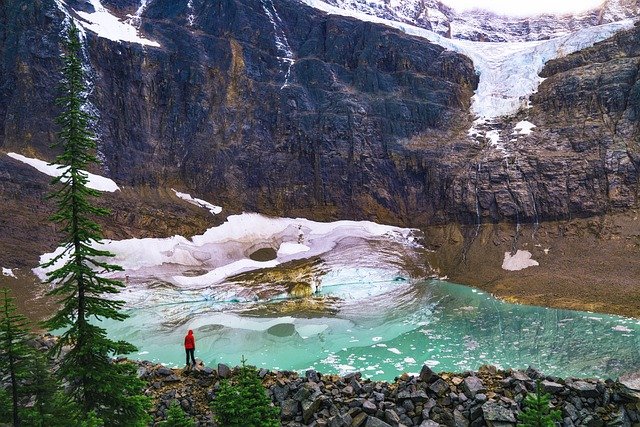
Ok, so back to your question: how long does it take for one glacier to melt completely? Ultimately, this comes down to how big is the yearly change in glacier mass induced by climate change compared to the size of the specific glacier. So there is no unique answer that applies to all glaciers of the same mountain range: if climate keeps promoting melting, then not all glaciers of the same mountain range would disappear at the same time. Everything else being the same, bigger glaciers would take longer to disappear (but take this just as a rule of thumb: also glaciers with more shaded aspects, or glaciers sitting at higher elevations would survive longer, so it’s not just as simple as size).
Anyways, details aside, and just to give you a sense for what the time scales are: If we think about mountain glaciers (like those in New Zealand or the Himalayas, or the European Alps), the time it takes for a glacier to disappear is anywhere between 10-20 years and 2-3 centuries.
This is a very good question. Our climate has changed since Earth was formed. These changes have resulted in radically different environments on Earth with very different plants and animals existing throughout the Earth’s history. During this time sea levels have fluctuated greatly also. One estimate of sea level rise over the past 40,000 years is about 105cm, or 1.05m.
Between 1920 and 2000, average sea level rise around Australia has been estimated as 1.2mm per year. The rate at which sea level is rising has increased since 1990, however.
The plot below shows how sea level has changed across the world. You can look at the website below the Figure to find out more information about sea level rise.

Climate models suggest that if humans undertake serious action to combat climate change, we can expect sea level to further increase by about between about 30 and 60cm by 2100. This increases to between 50 and 90cm if we continue living like we currently do.
The second image below shows how temperatures have changed over millions of years. You can also see some pictures of what animals may have been around at different times. Notice that human ancestors are only shown from around 4 million years ago.

The rapid climate change we’ve seen over recent decades and that is due to human actions is happening so fast that many species can’t adapt to it and are becoming endangered or even extinct. For example, in Tasmania there are a lot of concerns about some of our unique plants and animals – like Huon pine or Pencil pine. Warming oceans also mean we are seeing more pests like the Pacific Sea Star or Crown-of-thorns starfish in Tasmanian waters that have impacts on native species.
Earth’s climate has been changing since it was formed. Sometimes the climate changed quickly, other times more gradually, but there has always been climate change. Before humans this was caused by natural factors such as the strength of the sun, volcanic activity, even meteor impacts. For example, at the time of the dinosaurs, 250 – 65 million years ago, the global climate was hot and humid. Over the past million years, the Earth has gone through cycles of ice ages, where Earth’s surface temperature warmed and cooled by about 5 C every 100,000 years.
But if we ask: “how long has climate change caused by humans been around?” most scientists agree this started around the time human activity began to produce a lot of carbon dioxide. This happened about 200 years ago, at the start of what’s known as the Industrial Era. This is when coal-powered mechanical devices replaced human and animal labour and at the same time the number of humans on earth increased rapidly. Together these changes led to humans emitting more and more carbon dioxide into the atmosphere, and the beginning of human-caused climate change. Some scientists have argued that the earth was headed for another ice age around now, but the carbon dioxide produced by humans starting in the 1800s prevented this.
The screenshot below is from the Global Carbon Atlas. This is an interactive site that shows how human impact on the climate has changed through time- worth checking out. http://www.globalcarbonatlas.org/en/outreach (click on Enter the Past).

Finally, the graphs below can help you work out when climate change caused by humans started. The left-hand graph shows how global temperatures have changed over the last 2020 years. The right-hand side zooms in on the time since 1850 (when the temperatures are based on direct observations using thermometers). It compares the observed climate change (black line) with climate change simulated from a model that includes only natural factors like changes in the sun and changes in volcanic activity (green line), with climate change simulated by a model that includes both human and natural factors (orange line). The black line of the observations follows the orange line quite well, but both of them pull away from the green line starting around 1950. From this we can say that the climate change caused by humans has been around since at least 1950.
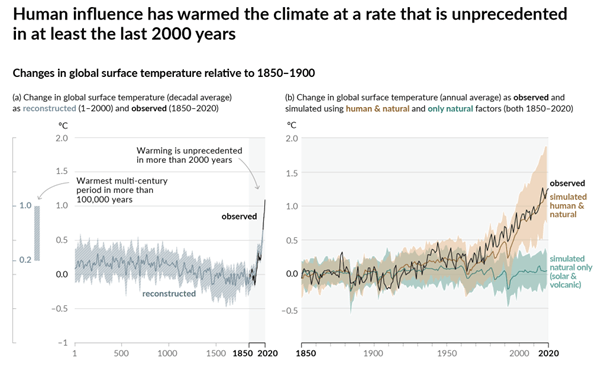
The climate was always changing, but it is important to understand that there is a big difference between natural climate change (or climate variability) and climate change due to human activities.
Natural climate change
Past natural climate changes have led to the extinction of many species, caused populations to migrate, as well as large changes to land temperatures, the amount of carbon dioxide and other greenhouse gases in the atmosphere, and ocean currents. In the last 800,000 years, for example, the Earth has gone through seven glacial cycles (ice ages), where the Earth was much cooler than today with expansive ice sheets covering much of the globe. At the end of each of these, the climate warmed, in some cases to warmer temperatures than today. The timing of these cycles is mostly controlled by slow changes in Earth’s orbit, which alter the way the Sun’s energy is distributed around the Earth.
Human-caused climate change
Humans have always affected and modified their environment but over the last 200 years, however, human activities have increasingly overridden natural climate processes, and since at least the middle of the 20th century, the warming we are seeing is undeniably a result of human activities. Our actions are causing rising carbon dioxide concentrations to levels higher than at any time in at least the last 800,000 years (see figure below), and rising temperatures in the atmosphere, ocean and on land are at a scale and rate never seen before. This is leading to the increasing frequency and intensity of extreme events such as bushfires, cyclones, heatwaves, floods and droughts we are experiencing.
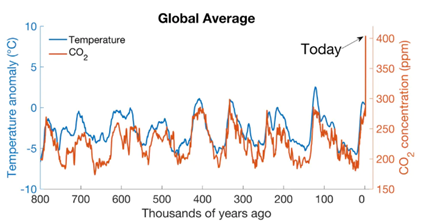
We’ve known about climate change and what causes it for a long time.
In fact, the first experimental observations of the effects of greenhouse gases were made by a female scientist, Eunice Foote, in 1856. In that year, she gave a talk at an American science meeting in which she described how glass jars containing different concentrations of water vapour, carbon dioxide and air heated up at different rates in the sun. Her research brought her to speculate that higher concentrations of carbon dioxide in the air could influence global temperatures.

Despite Eunice Foote’s discoveries Irish physicist, John Tyndall, is generally given the credit for first describing the 'Greenhouse Effect', in 1859. He published a series of studies showing how greenhouse gases such as carbon dioxide trapped heat in the Earth’s atmosphere.
In the 1950s and 1960s, scientists were developing a better understanding of what might be ahead of us in terms of climate change. Nobel Prize winning chemist, Glenn T. Seaborg warned in 1966 of a looming crisis, saying: "At the rate we are currently adding carbon dioxide to our atmosphere (six billion tons a year), within the next few decades the heat balance of the atmosphere could be altered enough to produce marked changes in the climate - changes which we might have no means of controlling”. In the 1950s, the New York Times reported that more carbon dioxide in the atmosphere “generated by man” was warming the climate.
In the 1970s the first global climate models were developed. They showed that it was impossible to increase carbon dioxide in the earth’s atmosphere and not have a global rise in temperature. In the 1980s, drilling ice cores deep into the Greenland and Antarctic ice allowed scientists to study bubbles of ancient air trapped there for thousands of years. This showed scientists that carbon dioxide concentrations in the Earth's atmosphere were historically much lower. This information helped confirm a remarkably consistent relationship between carbon dioxide in the atmosphere and Earth’s temperature.
In 1988, NASA scientist, James Hansen famously testified to the US Congress that “the greenhouse effect is here” and that “global warming has begun”. That same year, the Intergovernmental Panel on Climate Change (IPCC) was formed by the United Nations Environment Programme and the World Meteorological Organisation to study and report on climate change and its solutions. The IPCC and its thousands of scientists have since written numerous detailed reports on climate change, its impacts, and possible solutions. In 2007 it was awarded the Nobel Peace Prize for “efforts to build up and disseminate greater knowledge of man-made climate change, and to lay the foundations for the measures that are needed to counteract such change”. Today, more than 99% of scientists agree that global warming is anthropogenic – that is, caused by humans.
Despite centuries of science and decades of increasing evidence on the causes and consequences of climate change, plus growing consensus on the actions needed to mitigate it, there is one clear and crucial piece of evidence on the way humans have not dealt with the problem - and that is how carbon dioxide levels in the atmosphere keep rising. Carbon dioxide in the atmosphere was around 280 parts per million (ppm) in pre-industrial times (before we started burning a lot of fossil fuels). Today they are 420 ppm, and climbing.

This is not to say that we have ignored the science of climate change entirely. Some really important landmark decisions have been made on the strength of climate science – for example, the 2015 Paris Agreement where countries agreed to keep global temperature rise to no more than 2°C and to make the best efforts to keep it below 1.5°C. Climate scientists have been increasingly been sounding the alarm on the consequences of inaction. The IPCC’s Sixth Assessment report is the clearest yet on physical science behind climate change and warns of the severe consequences of not drastically cutting greenhouse gases this decade. The UN COP26 Climate Conference in Glasgow is now a crucial opportunity for policy makers to show they can finally take transformational action based on our very clear scientific understanding of climate change.
We are experiencing climate change here and now. Some of the changes might be subtle things that we don’t readily notice – like small changes in average summer day time temperatures, or the number of extreme heat days a year. Each decade since 1980 has been warmer than the last - but often people don't remember how these things were different in the past - we suffer from ‘shifting baselines’ which means we only recollect what happened in the recent past like last week or last year as a comparison for what we experience today. This means that these subtle changes may be hard to notice.
Some of the changes we are experiencing are actually much more dramatic – these include extreme weather events like unusual and severe storms or prolonged heat waves. Each year in Australia we are breaking lots of records. The Bureau of Meteorology puts out a great annual summary that you can refer to but I created a map collating notable examples for 2018 that gives you an idea of the types of climate change impacts and events we are currently experiencing.
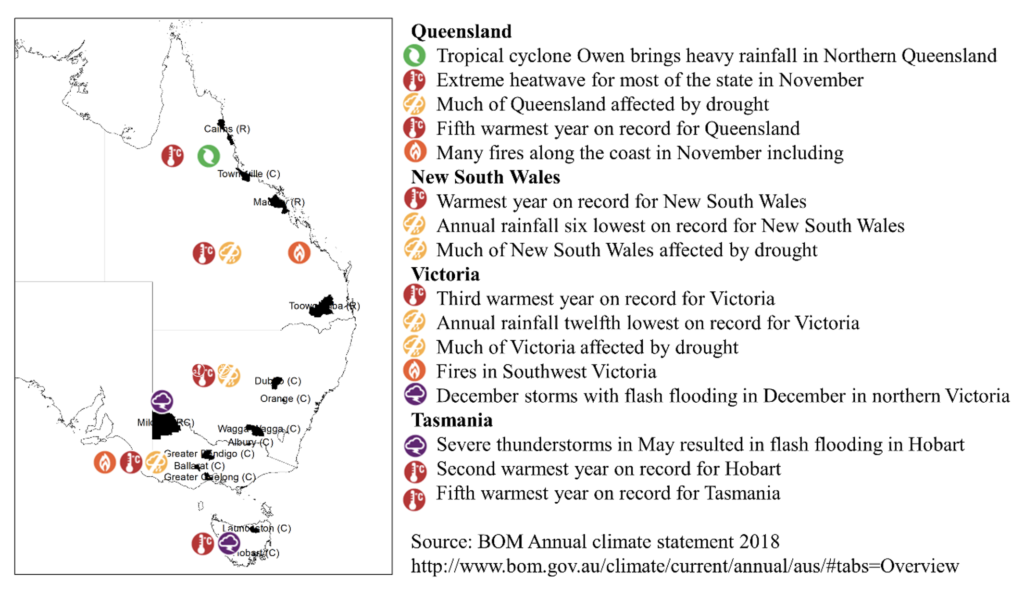
The impacts from these extreme events are being felt in different ways depending on who you are and where you live. But as examples – if your home is in a low lying coastal area the cost of flood insurance is often too high for the average home owner. And councils and state governments are considering planned retreats from the coast in terms of where they will support recovery from flood events versus where they will encourage home owners to move to as an alternative. Similar experiences are being felt in Australia’s fire prone city fringes where home owners have to monitor high fire danger index days and consider moving out of their homes on those days to protect themselves.
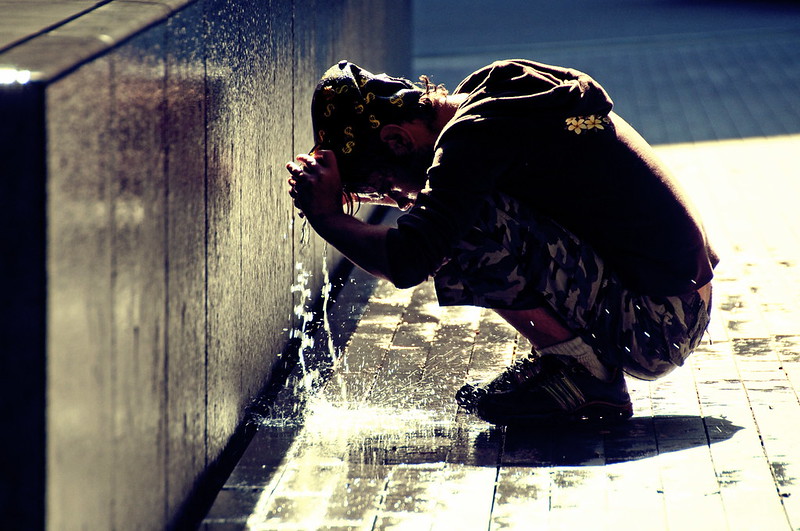
Other ways that individuals and families are already feeling the impacts are through their home environments. Many are finding their homes aren’t built for our new extreme heat days in summer and so they have to install air conditioners or run the AC for much longer periods of time resulting in substantial electricity bill increases. Individual, council, and state led adaptation measures are needed to make sure our built environments can cope with these changes from floods, fires, storms through to changes in heat.
Thank you for this very hard and important question. I realise that lots of children and adults currently feel worried or anxious about climate change and are concerned about how it will affect their future. If you feel like this, it doesn’t mean there is anything wrong with you. Actually, it means that you are a good, moral person who is interested in the world around you and someone who cares about your planet, your family and your friends.
There are lots of people who feel the same as you all around the world, and many people are working together to do the best they can to take action on climate change. Through the Curious Climate project, you might also meet some cool adults and scientists who can support your school if you or your friends would like to get involved in protecting the environment or climate action.
I don’t believe there will be a moment any time in the near future when large groups of people suddenly start dying of climate change. Climate change will affect different parts of the world in different ways, and at different times. In some places, weather events such as fires and floods, and hotter summers and colder winters will become more frequent, and this does put people at risk of injury and disease. For example, if you live in a fire prone area where your grandparents were evacuated once or twice in their lives, a family living in the same area today might experience evacuations more frequently. Similarly, heatwaves are dangerous for certain people in the community such as old people. If we have a very hot day and people who are sick or old don’t drink enough water or can’t keep their house cool, they are more at risk of having to go to hospital or dying. This already happens to some people every year in hot parts of the world. The health risks of living in hot weather will become more serious for vulnerable people if we have more very hot days within a year.
If a community does experience an event that is likely to be connected to climate change (e.g a bushfire) there are lots of things communities can do to heal themselves and recover. After the 2013 bushfire in Dunalley, the community came together quickly to rebuild the school so that the kids could be with their teachers and friends. In Australia, we have lots of good resources and lessons from past disasters to help us live through hard and difficult times. Together as a community we can learn how to adapt to living with the health threats of climate change. Even when serious disasters happen and some people are hurt or killed, we know that over time people in the community can heal and go on to live full and joyful lives.
This is a great question! The recent IPCC report (from the Intergovernmental Panel on Climate Change – which includes experts from Tasmania!) tells us that collectively, we will need to act fast to make changes to limit global warming to 1.5°C in the next decades. If we can manage to greatly reduce global greenhouse gas emissions (such as carbon dioxide, or CO2, by driving less or by burning less fossil fuels like coal) we can limit climate change. Most likely, it could take 20-30 years to see global temperatures become stable.
To help have quick and large impact, we need to take action at individual, collective and systematic levels:
At an individual level, each of us can do things like:
But remember that this will require more than just individual action. And whilst reducing emissions is a good thing, if we completely stopped emitting CO2 tomorrow, there wouldn’t be enough energy to generate electricity, or for us be able to travel and bring people and food to places around the world. That means we need to change our systems (like the ways we transport things, and make electricity) so that we can live without needing to use fossil fuels.
As you’ve outlined in your question, we need to work together to achieve these kinds of system changes to take action on climate. Using our voices to demand change is also a really important thing we can do. Find out more things we can all do on the 'What can I do?' page.